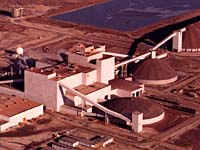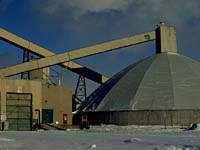

Since potassium chloride is a salt, it tends to be found where there has been intensive evaporation of salt water. Southern Saskatchewan was once covered by a dead sea; as it evaporated, it left very even layers of potash ore three to seven meters thick now located roughly a kilometre below the prairie. Potash occurs near the top of a thick sequence of halite and anhydrite comprising the Middle Devonian Prairie Formation. In Saskatchewan, this formation is at a depth of 400 m to over 2500 m and attains a maximum thickness of just over 200 m. The deposits in Saskatchewan, are part of a vast potash-bearing region extending across southern Saskatchewan and into Manitoba, Montana and North Dakota. The mineralized region is subdivided according to economic potential based on ore grade and required mining method. Conventional underground mining is conducted at depths down to about 1100 m whereas deeper ore is more suited to solution mining methods.
|
Mining Potash
Saskatchewan has eight conventional underground potash mines and two solution mines, where brine is pumped to the surface for recrystallization.
|
